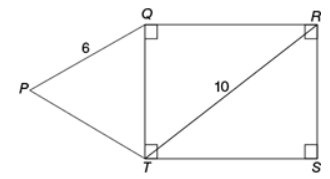Bunuel wrote:

In the figure above, what is the area of region PQRST ?
(1) PQ = RS
(2) PT = QT
Attachment:
2019-04-26_1406.png
: For geometry Data Sufficiency questions, we are typically checking to see whether the statements "lock" a particular angle, length, or shape into having just one possible measurement. This concept is discussed in much greater detail in the video below.
This technique can save a lot of time.
Now that we know PQ = RS, we know that RS = 6
Since the diagonal RT = 10, we can apply the Pythagorean Theorem to see that QR = 8, which means rectangle QRST has area 48
HOWEVER, we don't yet know the area of triangle PQT. Here's why:
Notice that no given information LOCKS IN the position of side PQ.
If we think of side PQ as a door with its hinge at point Q, then side PQ can freely move around, changing the area of triangle PQT
Since triangle PQT can have a variety of angles,
we cannot determine the area of region PQRSTSince we cannot answer the
target question with certainty, statement 1 is NOT SUFFICIENT
Statement 2: PT = QT Since we aren't provided any information about the lengths of PT and QT,
we cannot determine the area of region PQRSTSince we cannot answer the
target question with certainty, statement 2 is NOT SUFFICIENT
Statements 1 and 2 combined Statement 1 tells us that rectangle QRST has area 48
From statement 1, we also see that side QT = 6
Statement 2 tells us that PT = QT = 6
So, triangle PQT is an EQUILATERAL with sides of length 6.
So, we now have enough information to find the area of PQRST.
Since we can answer the
target question with certainty, the combined statements are SUFFICIENT
Answer: C
Cheers,
Brent
RELATED VIDEO



 45%
(medium)
45%
(medium)
 31%
(02:01)
wrong
31%
(02:01)
wrong  based on 3564
sessions
based on 3564
sessions








